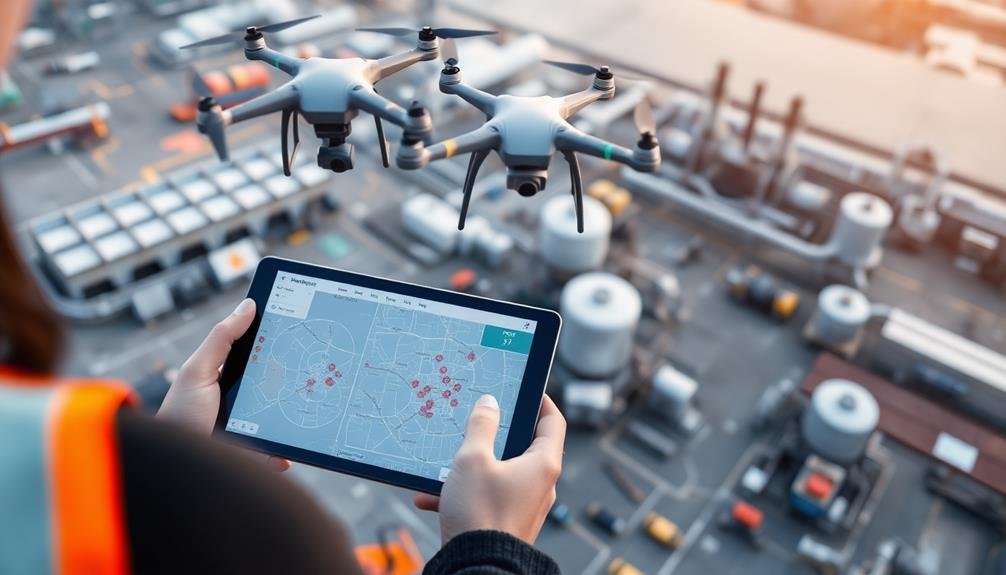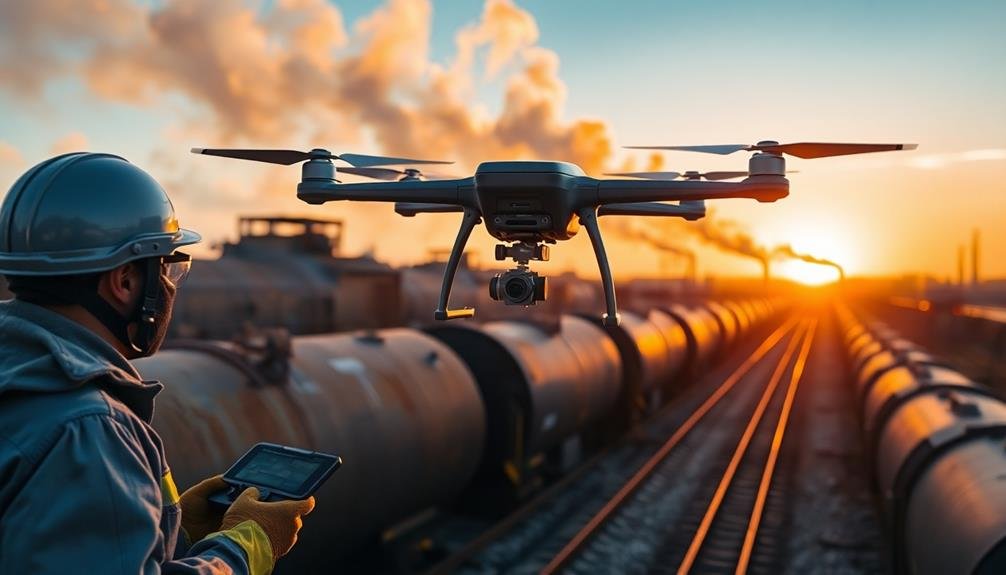To conduct safe drone inspections in hazardous areas, you'll need to follow these five essential tips. First, assess environmental risks by examining weather conditions and potential hazards. Second, choose appropriate drone equipment that's robust and equipped with necessary safety features. Third, develop thorough flight plans that account for obstacles and emergency scenarios. Fourth, train your operators to handle hazardous conditions and recognize warning signs. Finally, implement emergency response procedures to guarantee quick action during incidents. By adhering to these guidelines, you'll greatly reduce risks and improve the safety of your drone inspections. Discover how each tip can be applied to your specific situation for ideal results.
Key Takeaways
- Thoroughly assess environmental risks, including weather, terrain, and potential hazards specific to the inspection site.
- Select drones with robust features suited for hazardous conditions, including safety mechanisms and specialized sensors.
- Create detailed flight plans that account for obstacles, restricted areas, and potential emergency scenarios.
- Provide comprehensive training for operators, focusing on site-specific risks and emergency response procedures.
- Implement and regularly practice clear emergency protocols, including communication channels and evacuation procedures.
Assess Environmental Risks

Before launching your drone, it's crucial to assess environmental risks. Start by examining weather conditions, including wind speed, precipitation, and temperature. Strong winds can destabilize your drone, while rain or extreme temperatures may damage its components.
Check for electromagnetic interference from nearby power lines or communication towers that could disrupt your drone's signals.
Evaluate the terrain and potential obstacles in the inspection area. Identify tall structures, trees, or other hazards that might interfere with your flight path. Consider the presence of wildlife, especially birds, which could pose a collision risk.
If you're inspecting industrial sites, be aware of potential chemical emissions or explosive atmospheres that could affect your drone's operation or safety.
Assess the human activity in the area. Determine if there are populated areas nearby or ongoing operations that might be disrupted by your drone flight.
Review any restricted airspace or no-fly zones in the vicinity. Finally, consider the time of day and lighting conditions, as poor visibility can notably impact your ability to operate safely and capture quality data during the inspection.
Choose Appropriate Drone Equipment

Selecting the right drone equipment is essential for safe and effective inspections. You'll need to evaluate the specific requirements of your hazardous environment and choose drones and accessories that can withstand these conditions. Opt for drones with robust build quality, weather resistance, and long flight times. Make sure your drone has high-quality cameras and sensors for accurate data collection.
Don't forget about safety features like obstacle avoidance systems, return-to-home functions, and redundant communication links. These can help prevent accidents and equipment loss in challenging environments. Additionally, take into account specialized accessories like thermal cameras or gas sensors for specific inspection needs.
Here's a quick guide to help you choose appropriate drone equipment:
| Environment | Recommended Features | Example Drone |
|---|---|---|
| Chemical Plants | Gas sensors, explosion-proof | Flyability Elios 2 |
| Oil Rigs | Thermal cameras, wind resistance | DJI Matrice 300 RTK |
| Power Plants | High-resolution cameras, long range | Autel EVO II Pro |
Remember to regularly maintain and update your equipment to guarantee peak performance and safety during inspections. Always comply with local regulations and obtain necessary certifications for operating drones in hazardous areas.
Develop Comprehensive Flight Plans

Developing detailed flight plans is vital for guaranteeing safe and effective drone inspections in hazardous environments. You'll need to carefully map out your flight path, considering potential obstacles, restricted areas, and safety zones.
Begin by studying satellite imagery and site maps to familiarize yourself with the terrain and structures you'll be inspecting.
When creating your flight plan, include:
- Detailed takeoff and landing procedures, including backup locations
- Specific altitudes and speeds for different segments of the inspection
- Predetermined waypoints and hover positions for capturing essential data
You'll want to factor in weather conditions, such as wind speed and direction, which can affect your drone's performance and battery life.
Don't forget to plan for emergency scenarios, like sudden changes in weather or equipment malfunctions. Include clear communication protocols with ground personnel and establish no-fly zones to protect sensitive areas or personnel.
Before executing your flight plan, review it with all team members and stakeholders. Conduct a thorough pre-flight checklist and briefing to guarantee everyone understands their roles and responsibilities.
Train Operators for Hazardous Conditions

Proper training for drone operators is vital when conducting inspections in hazardous environments. You'll need to guarantee your operators are well-versed in the specific risks associated with the inspection site. This includes understanding potential chemical hazards, explosive atmospheres, or structural instabilities.
Train your operators to recognize warning signs and implement emergency procedures. They should be familiar with personal protective equipment (PPE) requirements and know how to use it correctly. Teach them to interpret real-time data from onboard sensors that detect dangerous gases or radiation levels.
You'll want to focus on situational awareness training, helping operators maintain a constant understanding of their surroundings. Practice flying in simulated hazardous conditions to build confidence and refine skills. Ascertain they're proficient in manual flight controls in case GPS or automated systems fail.
Incorporate scenario-based training that mimics potential emergencies. This might include responding to sudden changes in wind patterns, equipment malfunctions, or unexpected obstacles.
Don't forget to cover proper communication protocols with ground teams and emergency responders. Regular refresher courses and updated training on new technologies or procedures are vital to maintaining a high level of operator competence and safety.
Implement Emergency Response Procedures

An effective emergency response plan is vital for safe drone inspections in hazardous environments. You'll need to develop and implement procedures that address potential emergencies specific to your inspection site. Guarantee all team members are familiar with these protocols and can execute them quickly and efficiently if needed.
Your emergency response plan should include clear communication channels, designated safe zones, and specific actions for various scenarios. It's essential to:
- Establish a chain of command for decision-making during emergencies
- Create detailed evacuation routes and assembly points
- Designate roles and responsibilities for each team member
You should regularly review and update your emergency procedures to account for changes in the inspection environment or new potential hazards.
Conduct periodic drills to test the effectiveness of your plan and identify areas for improvement. Don't forget to coordinate with local emergency services and provide them with relevant information about your inspection activities.
Frequently Asked Questions
How Often Should Drones Be Inspected for Wear and Tear?
You should inspect your drone for wear and tear before and after each flight. It's essential to check it weekly, even if unused. Don't neglect regular maintenance, as it guarantees safe operation and extends your drone's lifespan.
What Insurance Coverage Is Recommended for Hazardous Area Drone Operations?
You'll want thorough liability insurance for your hazardous area drone operations. It's crucial to cover potential property damage, bodily injury, and equipment loss. Don't forget to include specific coverage for environmental risks and pollution incidents.
Are There Specific Certifications Required for Hazardous Area Drone Pilots?
You'll need specific certifications for hazardous area drone operations. Typically, you'll require a Part 107 license, HAZMAT certification, and industry-specific training. Some areas may demand additional qualifications, so always check local regulations before flying.
How Can Data Security Be Ensured During Drone Inspections in Sensitive Areas?
You'll need to encrypt data, use secure transmission protocols, and limit access to authorized personnel. Don't store sensitive information on the drone itself. Implement robust cybersecurity measures and follow industry-specific regulations for data protection.
What Are the Legal Implications of Accidental Drone Crashes in Hazardous Zones?
If you crash your drone in a hazardous zone, you'll face potential legal consequences. You could be liable for property damage, environmental harm, or safety violations. It's essential to understand local regulations and obtain necessary permits beforehand.
In Summary
You've now got the essential tips for conducting safe drone inspections in hazardous areas. Remember, safety is paramount. Always assess risks, use the right equipment, plan thoroughly, train your operators, and be prepared for emergencies. By following these guidelines, you'll minimize dangers and maximize the effectiveness of your drone inspections. Stay vigilant, keep learning, and don't hesitate to seek expert advice when needed. With careful preparation and execution, you'll successfully navigate even the most challenging inspection environments.

As educators and advocates for responsible drone use, we’re committed to sharing our knowledge and expertise with aspiring aerial photographers.




Leave a Reply